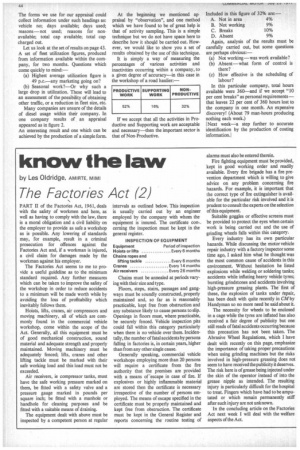know the law
Page 46

If you've noticed an error in this article please click here to report it so we can fix it.
by Les Oldridge, AMIRTE, MIMI
The Factories Act (2)
PART II of the Factories Act, 1961, deals with the safety of workmen and here, as well as having to comply with the law, there is a moral obligation and a civil liability on the employer to provide as safe a workshop as is possible. Any lowering of standards may, for example, result in a criminal prosecution for offences against the Factories Act and, if a workman is injured, a civil claim for damages made by the workman against his employer.
The Factories Act seems to me to provide a useful guideline as to the minimum standard required. Any further measures which can be taken to improve the safety of the workshop in order to reduce accidents to a minimum will be made worth while by avoiding the loss of profitability which inevitably follows them.
Hoists, lifts, cranes, air compressors and moving machinery, all of which are commonly found in the commercial vehicle workshop, come within the scope of the Act. Generally, all this equipment must be of good mechanical construction, sound material and adequate strength and properly maintained. Moving machinery must be adequately fenced; lifts, cranes and other lifting tackle must be marked with their safe working load and this load must not be exceeded.
Air receivers, ie compressor tanks, must have the safe working pressure marked on them, be fitted with a safety valve and a pressure gauge marked in pounds per square inch; be fitted with a manhole or handhole for cleaning purposes and be fitted with a suitable means of draining.
The equipment dealt with above must be inspected by a competent person at regular intervals as outlined below. This inspection is usually carried out by an engineer employed by the company with whom the equipment is insured. The certificate concerning the inspection must be kept in the general register.
INSPECTION OF EQUIPMENT
Equipment Period of inspection Hoists or lifts Every 6 months Chains ropes and
lifting tackle Every 6 months Cranes Every 14 months Air receivers Every 26 months
Chains must be annealed at periods varying with their size and type.
Floors, steps, stairs, passages and gangways must be soundly constructed, properly maintained and, so far as is reasonably practicable, kept free from obstruction and any substance likely to cause persons to slip. Openings in floors must, where practicable, be securely fenced. Vehicle inspection pits could fall within this category particularly when there is no vehicle over them. Incidentally, the number of fatal accidents by persons falling in factories is, in certain years, higher than from any other single cause.
Generally speaking, commercial vehicle workshops employing more than 20 persons will require a certificate from the fire authority that the premises are provided with a means orescape in case of fire. If explosives or highly inflammable material are stored then the certificate is necessary irrespective of the number of persons employed. The means of escape specified in the certificate must be properly maintained and kept free from obstruction. The certificate must be kept in the General Register and reports concerning the routine testing of alarms must also be entered therein.
Fire fighting equipment must be provided, kept in good working order and readily available. Every fire brigade has a fire prevention department which is willing to give advice on any problem concerning fire hazards. For example, it is important that the correct type of fire extinguisher is available for the particular risk involved and it is prudent to consult the experts on the selection of this equipment.
Suitable goggles or effective screens must be provided to protect the eyes when certain work is being carried out and the use of grinding wheels falls within this category.
Every industry has its own particular hazards. While discussing the motor vehicle repair industry with a factory inspector some time ago, I asked him what he thought was the most common cause of accidents in this environment. Without hesitation he listed explosions while welding or soldering tanks; accidents while inflating heavy vehicle tyres; bursting grindstones and accidents involving high-pressure greasing plants. The first of these, the explosion of tanks under repair, has been dealt with quite recently in CM by Handyman so no more need be said about it.
The necessity for wheels to be enclosed in a cage while the tyres are inflated has also received a fair degree of publicity but one still reads of fatal accidents occurring because this precaution has not been taken. The Abrasive Wheel Regulations, which I have dealt with recently on this page, emphasize the importance of taking proper precautions when using grinding machines but the risks involved in high-pressure greasing does not seem to have received the publicity it deserves. The risk here is of grease being injected under the skin of the operator instead of into the grease nipple as intended. The resulting injury is particularly difficult for the hospital to treat. Fingers which have had to be amputated or which remain permanently stiff after such injury are not unknown.
In the concluding article on the Factories Act next week 1 will deal with the welfare aspects of the Act.




























































































